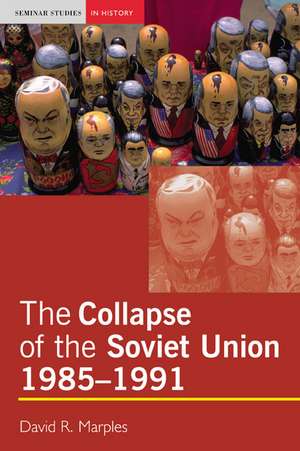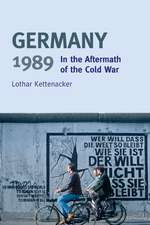The Collapse of the Soviet Union, 1985-1991
Autor David R. Marplesen Limba Engleză Paperback – 28 apr 2004
The collapse of the Soviet Union has widely been seen as the result of the arms race and Cold War, and the failure of the Soviet side to keep pace with new technology. This book argues that the disintegration was mainly a result of two interrelated factors: the rise of the Soviet national republics, and the manipulation of the new Russian presidency by Boris Yeltsin in what became a direct power struggle between Yeltsin and the Soviet leader, Gorbachev.
Written in a clear and accessible manner, the book provides:
- an explanation of how the national question came to dominate Soviet politics by 1990-1
- analysis of the economic crisis that occurred in the late 1980s
- a chapter devoted to the year 1991, from the referendum to reform the Soviet Union to the unforeseen dissolution of the country by December
- a discussion of the personalities of and political confrontation between the two key statesman: Gorbachev and Yeltsin
| Toate formatele și edițiile | Preț | Express |
|---|---|---|
| Paperback (1) | 310.45 lei 3-5 săpt. | +28.95 lei 7-13 zile |
| Taylor & Francis – 28 apr 2004 | 310.45 lei 3-5 săpt. | +28.95 lei 7-13 zile |
| Hardback (1) | 1272.54 lei 6-8 săpt. | |
| Taylor & Francis – 8 oct 2015 | 1272.54 lei 6-8 săpt. |
Preț: 310.45 lei
Nou
Puncte Express: 466
Preț estimativ în valută:
59.40€ • 62.02$ • 49.16£
59.40€ • 62.02$ • 49.16£
Carte disponibilă
Livrare economică 14-28 martie
Livrare express 28 februarie-06 martie pentru 38.94 lei
Preluare comenzi: 021 569.72.76
Specificații
ISBN-13: 9780582505995
ISBN-10: 0582505992
Pagini: 192
Dimensiuni: 156 x 234 x 10 mm
Greutate: 0.54 kg
Ediția:1
Editura: Taylor & Francis
Colecția Routledge
Locul publicării:Oxford, United Kingdom
ISBN-10: 0582505992
Pagini: 192
Dimensiuni: 156 x 234 x 10 mm
Greutate: 0.54 kg
Ediția:1
Editura: Taylor & Francis
Colecția Routledge
Locul publicării:Oxford, United Kingdom
Cuprins
INTRODUCTION
PART ONE: BACKGROUND
1. GORBACHEV COMES TO POWER
Political Overview
Glasnost
Social, Environmental, and Nuclear Power Issues
PART TWO: THE YEARS OF PERESTROIKA
2. THE ECONOMY AND FOREIGN POLICY
The Economy, 1985-90
Acceleration and Anti-Alcohol Campaigns
Coal Miners’ Strike
Economic Reform Programmes
Stagnation
The Pavlov Programme
Foreign Policy
Ideology and Propaganda
Arms Control
Architects of Soviet Foreign Policy
Eastern Europe
Ending the Cold War
3. THE NATIONAL QUESTION
The Submerged Dilemma
Nagorno-Katabakh
The Baltic States
Georgia, Ukraine, and Belarus
The Plenum on National Policy, September 1989
4. DOMESTIC POLITICS, 1989-MID-AUGUST 1991
The Congress of People’s Deputies and New Presidency
The 28th Party Congress and Aftermath
The Referendum of 17 March 1991
Toward a New Union Treaty
5. THE PUTSCH AND THE COLLAPSE OF THE USSR
The Putsch, 18-21 August 1991
Administrative Changes
The Failure of the Union Treaty
Yeltsin Consolidates His Power
The Belavezha Agreement
PART THREE: ASSESSMENT
6. WHY DID THE SOVIET UNION COLLAPSE?
PART FOUR: DOCUMENTS
Chronology
Glossary
Who’s Who
Guide to Further Reading
PART ONE: BACKGROUND
1. GORBACHEV COMES TO POWER
Political Overview
Glasnost
Social, Environmental, and Nuclear Power Issues
PART TWO: THE YEARS OF PERESTROIKA
2. THE ECONOMY AND FOREIGN POLICY
The Economy, 1985-90
Acceleration and Anti-Alcohol Campaigns
Coal Miners’ Strike
Economic Reform Programmes
Stagnation
The Pavlov Programme
Foreign Policy
Ideology and Propaganda
Arms Control
Architects of Soviet Foreign Policy
Eastern Europe
Ending the Cold War
3. THE NATIONAL QUESTION
The Submerged Dilemma
Nagorno-Katabakh
The Baltic States
Georgia, Ukraine, and Belarus
The Plenum on National Policy, September 1989
4. DOMESTIC POLITICS, 1989-MID-AUGUST 1991
The Congress of People’s Deputies and New Presidency
The 28th Party Congress and Aftermath
The Referendum of 17 March 1991
Toward a New Union Treaty
5. THE PUTSCH AND THE COLLAPSE OF THE USSR
The Putsch, 18-21 August 1991
Administrative Changes
The Failure of the Union Treaty
Yeltsin Consolidates His Power
The Belavezha Agreement
PART THREE: ASSESSMENT
6. WHY DID THE SOVIET UNION COLLAPSE?
PART FOUR: DOCUMENTS
Chronology
Glossary
Who’s Who
Guide to Further Reading
Descriere
The collapse of the Soviet experiment was one of the major turning points in twentieth century history. During the period of 'perestroika' the Soviet Union took the first steps to becoming a civil society and started to re-examine it's Stalinist past. This new text examines the Gorbachev years, asks why the Soviet Union collapsed in 1991, and offers a succinct and accessible interpretation of the remarkable events that led to the collapse.













